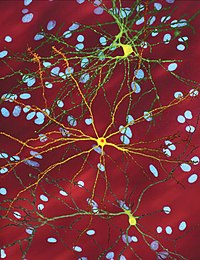
Photo from wikipedia
COVID-19 infection has a spectrum of variable clinical severity between populations because of their characteristic demographic features, co-morbidities, and immune system reactions. This pandemic tested the healthcare system’s preparedness, which… Click to show full abstract
COVID-19 infection has a spectrum of variable clinical severity between populations because of their characteristic demographic features, co-morbidities, and immune system reactions. This pandemic tested the healthcare system’s preparedness, which depends on predictors of severity and factors related to the duration of hospital stays. Therefore, we carried out a single-center, retrospective cohort study in a tertiary academic hospital to investigate these clinical features and predictors of severe disease and study the different factors that affect hospital stay. We utilized medical records from March 2020 to July 2021, which included 443 confirmed (positive RT-PCR) cases. The data were explained using descriptive statistics and analyzed via multivariate models. Among the patients, 65.4% were female and 34.5% were male, with a mean age of 45.7 years (SD ± 17.2). We presented seven age groups with ranges of 10 years and noticed that patients aged 30–39 years old comprised 23.02% of the records, while patients aged 70 and above comprised 10%. Nearly 47% were diagnosed as having mild, 25% as moderate, 18% as asymptomatic, and 11% as having a severe case of COVID-19 disease. Diabetes was the most common co-morbidity factor in 27.6% of patients, followed by hypertension (26.4%). Our population’s predictors of severity included pneumonia, identified on a chest X-ray, and co-morbid conditions such as cardiovascular disease, stroke, ICU stay, and mechanical ventilation. The median length of hospital stay was six days. It was significantly longer in patients with a severe disease and who were administered systemic intravenous steroids. An empirical assessment of various clinical parameters could assist in effectively measuring the disease progression and follow-up with patients.
Journal Title: Healthcare
Year Published: 2023
Link to full text (if available)
Share on Social Media: Sign Up to like & get
recommendations!